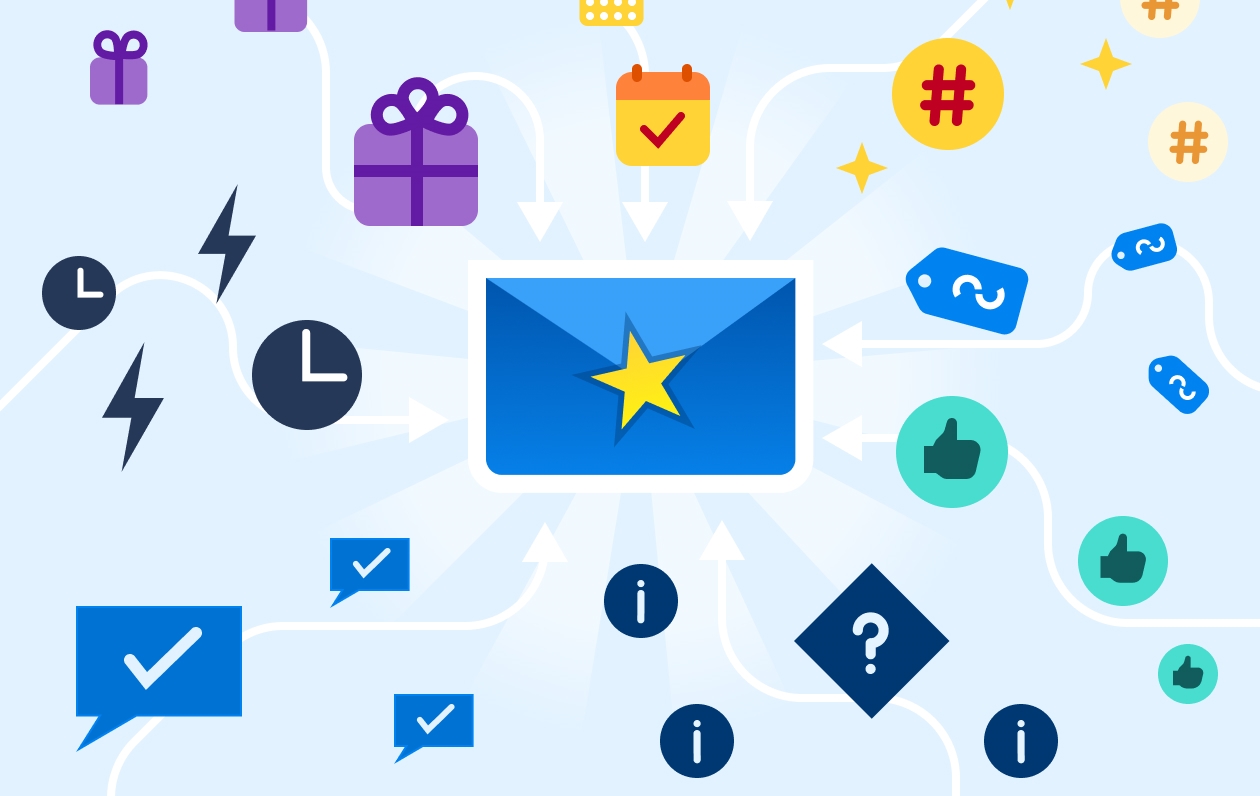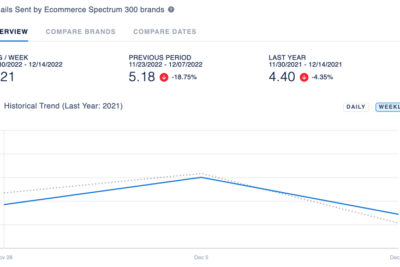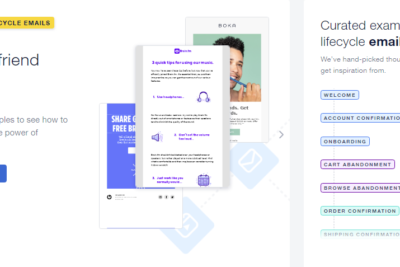Whenever we talk with email marketers, one problem comes up all the time: “I need new ideas for my email campaigns, but I have no time to plan!”
We hear you! Every email marketer comes up against this challenge sooner or later. Email marketers are stretched so thin these days and struggle to find the time they need for strategic and creative planning.
But staying fresh and attention-getting is more important than ever. Standing out in the inbox will be even harder now because more marketers say they plan to ramp up volume in 2022.
So let MailCharts help you with the planning part. Inspiration is all around. We’ll help you find it and use it successfully – whether you need a fast idea now or a way to keep coming up with new ideas regularly.
What you’ll discover here are ideas you can use TODAY to inspire next week’s email campaign. But that’s not all! You can customize each idea for different brands, holidays, customer segments and purposes.
1. FOMO
Old-time marketers would call this “urgency”, but today we think of it as the fear of missing out, or FOMO. Your goal is to persuade people to act right now instead of waiting to be reminded or assuming they have all the time in the world to click on your email.
Use FOMO judiciously, though. Your customers will see right through you if you use “Act now or lose out!” too often. For a new twist on FOMO, try one of these approaches:
• Get on the waitlist. This is a great way to spark interest in a new product that hasn’t launched yet or one that sold out even before you could send the email campaign. That’s how jewelry brand Mejuri promoted a set of earrings that debuted on the website but sold out immediately.
A waitlist like this is a single-use email list that does double duty. It lets you contact your most interested customers, and it gives you more data you can use to refine your segmentation and targeting.
If your product has a long consideration cycle or manufacturing process, like home goods or furniture, a waitlist can attract the first hands-up signal from potential buyers.
Do this first: Check with your data team to be sure your email platform will support this kind of newsletter, and be very clear that the waitlist is just for this product announcement. If you also offer the waitlist on your website, give nonsubscribers an option to opt into your email program.
• Sold out: No time to build a waitlist? No problem! If your product sold out before you could send your campaign, you won’t have to wait until the next shipment comes in to grab some sales. Offer a comparable product or the same product in a different color or size.
Here, your product or brand manager will be your best friend. Ask them to let you know when the product is sold out – the last thing you want is a queue full of angry customers who actually DID miss out – and what product you could swap in to replace it.
This approach works well if you’re doing a timed multi-item rollout, as cookware brand Our Place did when it introduced one new color of an item each day. As soon as that color sold out, the team sent out an email update, along with a link to the website so customers could queue up for the next color drop.
2. Build trust with social proof
People look to others for reassurance or approval. Testimonials from public figures or fellow customers are the oldest form of social proof. You could ask for positive comments, but that takes time you don’t have to turn out a fresh campaign next week. Instead, dip into your customer reviews and ratings, or raid your social media to find out what people are saying, and post it in your campaign.
Magic Spoon turns the social proof concept into an irresistible email with the subject line “We love hate mail.” Of course, it’s really a lovefest, but the concept is a must-open.
Skincare brand Saje Natural Wellness turns social proof into a triple-threat email that promotes its user community, a high-profile influencer, and a product, all in one. It’s a bold statement designed to help hesitant buyers feel more confident about buying, but you could make this kind of email work with just one element.
Safety in numbers is another sign of social proof. If you’re McDonald’s, you say “Billions and billions served. Sheertex announced a major sales milestone, which helps customers see how much other buyers have adopted the brand.
Would this work for another brand? Absolutely! Any popular product in your inventory probably has a sales statistic that would imply to other customers they’re doing something right because everybody else is buying the same thing.
Do this first: Ask your brand or sales manager to let you know when a hot new product or perennial best-seller is about to hit a sales milestone. Use the lead time to pull a creative campaign together, such as a thank-you with a modest discount to encourage purchases.
3. Tap into the zeitgeist
What are people talking about right now? “Squid Games”? “Dancing with the Stars”? Champions League soccer? If it’s a hot viral topic, capitalize on the conversation even if it doesn’t relate directly to the product you’re selling.
When Facebook, Instagram, and WhatsApp went dark briefly in October 2021, many brands seized the moment and cranked out cheeky campaigns like this one from Cratejoy. The fun begins with this attention-getting subject line: “The internet is broken! Here’s 40% Off!”
Hooks like this help you keep your emails fresh and exciting. You can build your email around the event, or just tack on a catchy subject line like this one from Chubbies just before Halloween: “Squid Games costumes are sold out.”
Do this first: Your social media team should have a good grasp of current hot topics and might even be using this tactic to build engagement right now. If not – or if you’re the social media team too, bookmark these trending-topics sites and check them regularly to see what you could turn into a fun campaign:
4. Give something away
Everybody loves something for nothing. If you have the time, budget, and legal know-how, you can organize a major sweepstakes. But if you want to generate more clicks right away, just keep it simple and offer up a small but tempting freebie.
It could be an item from a new collection, a free membership, extra points in your loyalty program or something else that your customers would value without having to pay for it. You could frame it as a customer thank-you or as a way to build up your social media following, as Shrimps does here:
You can also team up with another brand on your giveaway. Here are three options:
- Ecommerce shops that represent multiple brands
- Small or emerging brands that want wider exposure
- Two separate brands that have a natural affinity
You can see this at work with the email below. Wellness brand Recess doesn’t sell Bearaby’s weighted blankets, but the co-branded promotion is a complementary fit for both brands.
5. Add to calendar
The other side of “Don’t miss out” is “Be the first.” Here, customers aren’t playing catch-up. They’re acting on the human appreciation for VIP treatment and the lure of being first in line for a hot product.
The “Set Your Alarm” link in this Our Place email sends a calendar invite to the subscriber’s email address if they click the link. The invite, in turn, sends an automated reminder from the subscriber’s calendar app. That’s one less email you have to send!
This calendar invite prods customers to get in on a sale, but it can be just as effective if you’re dropping a major seasonal collection or event. Brands with both stores and e-commerce operations use these effectively to promote store openings or hybrid in-store/online events.
Do this now: Team up with your email designer or development team to create the calendar invite. Also, offer it in a wide range of calendar apps: iOS, Outlook, Gmail, Yahoo! and more. If you have access to a real-time email platform like Liveclicker and Movable Ink, adding “add to calendar” could be as easy as drag-and-drop.
6. Staff picks
Having a robust search engine on your website is great for helping customers track down what they want, but the human touch can be just as effective. Who knows your products better than you? Ask your buyers, brand managers, and any other hands-on people in your company for their favorite items and what makes them special. This can be efficient not only for email marketing, but also for other kind of strategies such as how to sell on Instagram.
This approach works for any brand, but especially if you sell highly customized items or things that people use every day, such as beauty, cookware, furniture, home and garden equipment or sports gear. Need a template? This email from Birdies nails it – the product doesn’t get lost in the copy, but the image doesn’t overwhelm the selling points in the copy.
Here’s another take that also puts your brand’s authority front and center (important for building trust, BTW!). The Sill helps online plant buyers shop successfully with a how-to-buy guide. A side benefit is that this move can reduce complaints and returns, for which your customer service team and your CFO will thank you:
7. Product/collection launch
Here’s a spectacular “launching new collection” email from timepiece brand Filippo Loretti. It has an attractive and cohesive design (the vintage look is spot-on for this brand). It piques curiosity while giving fans all the details they need to be online for the great unveiling, plus a waitlist to reward superfans with early access.
But that’s a lot to ask if you are short on time and your email designer is buried under other work. Skip all the fancy touches and send your customers a just-the-basics message like this one from Lovesac. Here’s a twist – it’s not as basic as it looks but it doesn’t require a lot of extra work to make it valuable for you and your customer alike.
So what’s so not-basic about this no-frills collection announcement? It hints at something big, collects mobile numbers for text updates, and gives customers a link to find their nearest store. All of these links will give you valuable data from customers who click them, such as adding mobile numbers to your customer records or connecting customers to location data that might be disabled now thanks to Apple’s new privacy feature that masks open data.
And if your brand doesn’t do mobile updates or have physical locations? You’re still good – just choose an intriguing subject line and copy that whets your readers’ appetites to learn more.
8. Pop quiz
Here’s an easy win for brands that want to learn more about their customers’ preferences. No spreadsheets needed! Just create an email, add two or three versions of a popular product, and ask readers to choose their favorite. Link each image to the product’s landing page, and boom! You have click data, preference data, and maybe even some sales.
Although this Trade Coffee isn’t technically a quiz, you could easily adapt this format for a simple quiz:
Do this first: Even a simple quiz can help you gather extra customer data. To get the most participation, think it through first. What products do you want to know about? What do you want to learn from your customers? If you have a data or CRM team, check with them to see what they would recommend.
Your next move: Share the love!
MailCharts understands the pressure e-commerce email marketers like you have to deal with because many of us have been on the email front lines, too, and we know your pain. If you find our suggestions and tactics useful, share this post with a fellow email marketer.

















